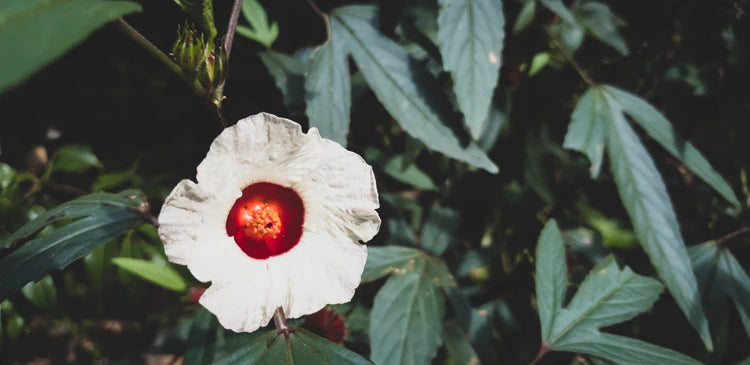hikma was born from the desire to reintroduce personal and collective rituals into your lifestyle. We understand the tradition and science of pure botanicals—and how to formulate them for a better way of living. Inspired by both knowledge and legacy, hikma’s products are expertly developed in small batches with formulations that are stripped back to the basics—allowing those all-natural ingredients to take center stage.

Hibiscus
Hibiscus sabdariffa
Common name: Hibiscus, roselle, Sudanese tea, red tea, Jamaica sorrel
Arabic name: كركدية
Family: Malvaceae
Parts Used: Calyces
Actions:
Astringent
Balances hormones
Antibacterial
Anti-catarrhal
Anti-inflammatory
Antimicrobial
Antioxidant
Diuretic
Cardiotonic
Hepatic
Hypocholesterolemic
Immune Stimulant
Reproductive tonic
Taste: Astringent, sour.
Energy: Cooling, drying.
Native To: North Africa, Southeast Asia.
Geographic Distribution: Tropical and subtropical regions throughout world.
Botanical Description: Hibiscus sabdariffa has large flowers that can be a variety of colors (typically ranging from yellow to white to pink) with a reddish-purple center. The flowers are up to 4 inches in diameter. The calyx, which is the outermost whorl of the flower, consists of dark red sepals that become fleshy and fruit-like after the flower is done blooming. The calyx protects a light green to brown ovoid fruit as it develops and matures. The erect shrub is up to 8 feet tall and has 3-7 lobed palmate leaves arranging alternately on the branching reddish stems. Hibiscus grows from a long taproot.
History and folklore: The luscious calyces are harvested and used fresh or dried to make tea, tincture, glycerite, syrup, infused honey, or jams. Hibiscus tea is a beloved drink in many cultures throughout the world, often prepared sweetened and with cinnamon, cloves, nutmeg, ginger, lemon juice, or mint. It is called sorrel in the Carribbean, agua de Jamaica in Latin America, karkade in north Africa, Italy, and Russia, arhul ka phool in India, and sour tea in Iran. Traditionally, hibiscus calyces have been used throughout the world as the aforementioned beverages as “refrigerants” to cool the body; in Egypt as a diuretic and for cardiac and nerve diseases; in North Africa for coughs and sore throats; in Europe for colds and upper respiratory tract congestion, sleeplessness and as a laxative and diuretic; and in Iran for hypertension
Uses: Hibiscus is high in vitamin C. It contains plant acids (oxalic, malic, hibiscic, and citric) responsible for the tart flavor, anthocyanins, mucilaginous polysaccharides, anti-inflammatory polyphenols, flavonoids, and minerals such as iron, phosphorus, calcium, magnesium, aluminum, magnesium, sodium, and potassium. It is rich in antioxidants. The sour, astringent, cooling nature of hibiscus help to cool and regulate the body’s temperature as well as tone and cool irritated tissue and mucus membranes throughout the digestive tract and genitourinary system. This is particularly indicated in the case of overheated states and inflammation in the body, such as irritation in the liver, stomach, bladder, urinary tract, uterus, or colon. Hibiscus is also clearing, helping to move stuck mucus and energy throughout the digestive system, lungs, circulatory system, and reproductive system. Due to its high vitamin C and antioxidant content, hibiscus helps strengthen the immune system and acts as an immunostimulant to help fight off colds and infections. Its antioxidants keep our cells healthy, while its ability to help stuck mucus to flow helps alleviate congestion in the respiratory system. Hibiscus is purported to support cardiovascular health, reducing and maintaining healthy blood pressure and cholesterol levels. Hibiscus is an ally for the urinary system, as well. Hibiscus is a great plant for prevention of urinary tract infections (UTIs) due to its antibacterial activity and for treatment of bladder infections. Due to its diuretic action, hibiscus is helpful for prevention of uric acid buildup. Hibiscus is an ally for the reproductive system as well. It is balancing to hormones, its astringent nature is useful for regulating menstrual flow and checking excessive bleeding, and its antispasmodic action helps relieve menstrual cramps. On an energetic level, hibiscus is a very sensual, pleasureful plant, its diuretic properties encouraging movement and release in the sacral region while its pleasureful nature helps one open to intimate connection and receiving.
Safety: Hibiscus sabdariffa is considered safe. Extremely high doses of the extract could be toxic to the liver. Hibiscus should be avoided during pregnancy as there are some reports of it stimulating menstruation.

